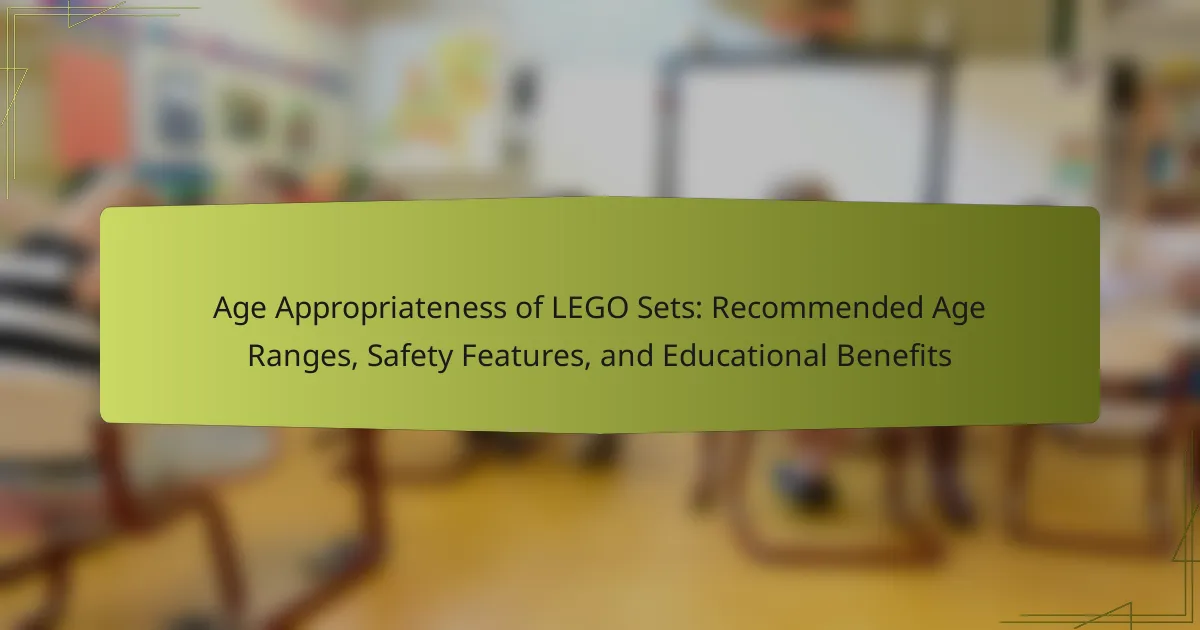LEGO sets are categorized by age appropriateness, ranging from 1.5 years to adults, with specific recommendations indicated on their packaging. Sets like LEGO Duplo are designed for younger children aged 1.5 to 5 years, while standard LEGO sets cater to ages 4 and up, and more complex LEGO Technic sets target ages 10 and older. Safety features, including non-toxic materials and rounded edges, ensure that these sets are safe for users, particularly children. Additionally, LEGO sets provide educational benefits by enhancing problem-solving skills, fostering creativity, and supporting fine motor skill development, making them valuable tools for learning across various age groups.

What is the age appropriateness of LEGO sets?
LEGO sets are designed for various age groups, typically ranging from 1.5 years to adults. The age appropriateness is indicated on the packaging with age recommendations. For instance, LEGO Duplo sets are suitable for younger children aged 1.5 to 5 years. Standard LEGO sets generally cater to ages 4 and up. More complex sets, like LEGO Technic, are intended for ages 10 and older.
These age ranges ensure safety and developmental suitability. LEGO also incorporates safety features, such as rounded edges and non-toxic materials. The age recommendations are based on research into children’s motor skills and cognitive development. This design consideration helps promote safe and enjoyable play experiences for all age groups.
How are age ranges determined for LEGO sets?
Age ranges for LEGO sets are determined based on the complexity of the building experience and safety considerations. The LEGO Group conducts extensive research on child development. They consider cognitive, motor, and social skills at various ages. Each set is tested to ensure it is safe and appropriate for the intended age group. For instance, younger sets often feature larger pieces to prevent choking hazards. The age recommendations aim to match the skill level required to build the set. This ensures that children can engage with the product successfully and safely. Additionally, feedback from parents and educators influences these age guidelines.
What factors influence the recommended age for each LEGO set?
The recommended age for each LEGO set is influenced by several factors. These factors include the complexity of the build, the size of the pieces, and the intended learning outcomes. Complexity refers to the number of steps and the intricacy of the design. Smaller pieces may pose choking hazards for younger children. Intended learning outcomes can focus on developing fine motor skills or problem-solving abilities. LEGO evaluates these factors to ensure safety and educational value. The age recommendations are based on extensive testing and research. This ensures that children can engage with the sets appropriately, enhancing their play experience while minimizing risks.
How do developmental milestones relate to LEGO age recommendations?
Developmental milestones are key indicators of a child’s growth and abilities. LEGO age recommendations align with these milestones to ensure safety and engagement. For instance, younger children may lack fine motor skills needed for small pieces. LEGO sets for this age group typically feature larger blocks. As children grow, they develop problem-solving skills. LEGO sets for older children incorporate more complex designs. This progression supports cognitive development through play. Research shows that age-appropriate toys enhance learning and creativity. Therefore, LEGO age recommendations are designed to match developmental stages effectively.
Why is age appropriateness important for LEGO sets?
Age appropriateness is crucial for LEGO sets to ensure safety and optimal developmental benefits. LEGO sets designed for specific age groups consider the physical and cognitive abilities of children. Younger children may struggle with small pieces, posing a choking hazard. Age-appropriate sets also align with developmental milestones, enhancing problem-solving and fine motor skills. For example, sets for toddlers often feature larger blocks that are easier to handle. This design approach fosters creativity while minimizing frustration. Research indicates that appropriate play experiences can significantly impact children’s learning outcomes. Thus, age appropriateness in LEGO sets is essential for safety and educational effectiveness.
What are the risks of giving age-inappropriate LEGO sets?
Giving age-inappropriate LEGO sets can pose several risks. Younger children may face choking hazards from small pieces that are not suitable for their age group. These small components can easily be swallowed or inhaled, leading to serious health issues. Additionally, complex sets intended for older children may frustrate younger users. This frustration can lead to negative experiences with play and creativity. Furthermore, age-inappropriate sets may lack the necessary safety features for younger users. For example, sharp edges or small parts can increase the risk of injury. Overall, selecting appropriate LEGO sets based on age recommendations is crucial for safety and enjoyment.
How does age appropriateness enhance the play experience?
Age appropriateness enhances the play experience by ensuring that activities align with a child’s developmental stage. When toys are designed for specific age groups, they cater to the skills and interests of that age range. For example, younger children benefit from simple, large pieces that promote motor skills. In contrast, older children can engage with more complex sets that challenge their creativity and problem-solving abilities. Research indicates that age-appropriate play fosters confidence and encourages exploration. According to the American Academy of Pediatrics, toys that match developmental stages lead to more meaningful play experiences. This alignment promotes engagement, learning, and enjoyment, making playtime more beneficial and enjoyable for children.

What are the recommended age ranges for LEGO sets?
LEGO sets are recommended for various age ranges. Typically, sets are categorized by age groups such as 1-3 years, 4-7 years, 8-12 years, and 13 years and older. For example, Duplo sets are designed for younger children aged 1-3 years. These sets feature larger bricks for safety and ease of use. Sets for ages 4-7 include simpler builds with themes that appeal to early school-age children. More complex sets for ages 8-12 offer intricate designs and advanced building techniques. Finally, sets for ages 13 and older cater to teens and adults, often featuring sophisticated models and themes. This age categorization ensures that the sets are age-appropriate and safe for the intended users.
How do LEGO sets cater to different age groups?
LEGO sets cater to different age groups by offering a variety of themes and complexity levels. For young children, sets are designed with larger bricks and simpler designs, ensuring safety and ease of use. These sets often feature popular characters and bright colors to engage younger audiences. As children grow, LEGO introduces more intricate sets that challenge their building skills and creativity.
For example, sets aimed at ages 7-12 include more detailed instructions and smaller pieces. These sets often focus on specific themes like architecture or vehicles. Teenagers and adults can enjoy advanced sets, such as the LEGO Technic series, which require higher levels of problem-solving and engineering skills.
Additionally, LEGO has created specific lines, like LEGO Friends and LEGO City, to appeal to various interests and demographics. This approach allows LEGO to maintain engagement across different age groups, promoting both play and learning.
What are the specific age ranges for various LEGO themes?
LEGO themes have specific age ranges tailored to different developmental stages. For instance, LEGO Duplo is designed for ages 1.5 to 5 years. This theme features larger bricks for safety and ease of use. LEGO City and LEGO Friends are suitable for ages 5 and up. These themes encourage imaginative play and social interaction. LEGO Technic is recommended for ages 9 and older. It introduces more complex building techniques and engineering concepts. LEGO Creator sets are aimed at ages 7 and above, offering versatile building experiences. Lastly, LEGO Architecture is intended for ages 12 and up, appealing to older builders interested in design and architecture. These age ranges ensure that each theme is appropriate for the skills and interests of children at various developmental stages.
How does the complexity of LEGO sets vary by age range?
LEGO set complexity increases with age range. Younger children, typically ages 4 to 7, engage with simpler sets. These sets often feature larger bricks and fewer pieces. They focus on basic building skills and imaginative play. As children age, from 8 to 12, sets become more intricate. These include smaller pieces and more complex designs. They challenge builders to develop problem-solving skills. For teenagers and adults, sets can contain thousands of pieces. They often represent advanced themes and detailed models. This progression aligns with cognitive development and motor skills enhancement. LEGO’s age recommendations reflect this complexity variation.
What are the age-specific benefits of LEGO sets?
LEGO sets provide various age-specific benefits that enhance developmental skills. For toddlers aged 1-3, large bricks promote fine motor skills and hand-eye coordination. Preschool-aged children, 4-5 years, engage in imaginative play and develop social skills through group building activities. Children aged 6-8 benefit from problem-solving skills as they follow complex instructions. For ages 9-12, LEGO sets encourage creativity and critical thinking through design and engineering challenges. Teenagers, 13 and older, can explore advanced building techniques and project management skills. Research shows that LEGO play improves cognitive abilities across all age groups, as highlighted by studies from the University of Cambridge.
How do LEGO sets support cognitive development in young children?
LEGO sets support cognitive development in young children by enhancing problem-solving skills and encouraging creativity. Building with LEGO requires children to think critically about how to assemble pieces. This hands-on activity fosters spatial awareness and fine motor skills. Children learn to plan and execute their designs, which develops logical thinking. Research shows that engaging in constructive play promotes cognitive flexibility. A study by Fisher, Hirsh-Pasek, Golinkoff, and Singer (2011) highlights that children who engage in building activities show improved cognitive abilities. LEGO sets also encourage cooperative play, enhancing social skills and communication. These interactions further contribute to cognitive development.
What skills do older children develop through LEGO play?
Older children develop various skills through LEGO play, including problem-solving, creativity, and fine motor skills. Problem-solving skills are enhanced as children figure out how to assemble complex structures. Creativity is fostered as they design unique builds from their imagination. Fine motor skills improve through the manipulation of small LEGO pieces. Additionally, spatial awareness is developed as children understand how different pieces fit together in three-dimensional space. Collaborative skills are also nurtured when children work together on projects. Research shows that hands-on play with LEGO can significantly boost cognitive development. Overall, LEGO play provides a multifaceted approach to skill development for older children.

What safety features are included in LEGO sets?
LEGO sets include several safety features designed to protect users, especially children. One key feature is the use of non-toxic materials in all bricks. LEGO bricks are made from ABS plastic, which is safe for children. Additionally, LEGO sets are tested rigorously to meet safety standards globally. They undergo assessments for small parts to prevent choking hazards. Sets are labeled with age recommendations to guide appropriate use. The company also provides clear assembly instructions to minimize misuse. These safety measures ensure a secure play experience for users.
How does LEGO ensure the safety of its products for children?
LEGO ensures the safety of its products for children through rigorous testing and compliance with safety standards. The company conducts over 1,000 safety tests on each product. These tests assess factors such as choking hazards, sharp edges, and toxic materials. LEGO adheres to international safety regulations, including EN71 and ASTM F963. The brand also employs child development experts to evaluate age-appropriate designs. Additionally, LEGO provides clear age recommendations on packaging. This transparency helps parents select suitable sets for their children. By prioritizing safety, LEGO builds trust with consumers and enhances child play experiences.
What materials are used in LEGO sets to enhance safety?
LEGO sets use high-quality plastic materials, specifically acrylonitrile butadiene styrene (ABS), to enhance safety. ABS is known for its durability and strength, reducing the risk of breakage. The smooth surface of ABS minimizes sharp edges, preventing injuries during play. Additionally, LEGO employs non-toxic colorants in its products. This ensures that the bricks are safe for children, even if they are put in the mouth. LEGO also adheres to strict safety standards, including EN71 and ASTM F963. These standards guide the testing of materials for safety in toys. The combination of these materials and safety regulations makes LEGO sets safe for children.
How are small parts managed in relation to safety standards?
Small parts in LEGO sets are managed through strict adherence to safety standards. These standards are established by organizations such as ASTM International and EN71 in Europe. Manufacturers conduct rigorous testing to ensure small parts do not pose choking hazards. For example, small parts are designed to be larger than a specified size to minimize risk. Additionally, packaging includes age recommendations to guide consumers. Regular audits and compliance checks are performed to maintain safety. The U.S. Consumer Product Safety Commission monitors these regulations to protect children. These measures collectively ensure that small parts in LEGO sets are safe for their intended age groups.
What safety certifications do LEGO sets have?
LEGO sets have several safety certifications, including EN71, ASTM F963, and ISO 8124. EN71 is a European standard for toy safety, ensuring that products meet health and safety requirements. ASTM F963 is an American standard that specifies safety aspects for toys, including mechanical and physical properties. ISO 8124 is an international standard for toy safety, covering various aspects of safety for children’s toys. These certifications confirm that LEGO sets are tested for harmful substances and mechanical hazards, ensuring they are safe for children to play with.
What do safety certifications indicate about LEGO sets?
Safety certifications indicate that LEGO sets meet specific safety standards for children. These certifications ensure that the materials used are non-toxic and safe for play. They also confirm that the sets do not contain small parts that could pose choking hazards. Organizations like ASTM International and EN71 provide these certifications. Compliance with these standards is crucial for the protection of young users. Regular testing is conducted to maintain these safety certifications. This process includes evaluating the physical and chemical properties of the sets. Consequently, safety certifications instill confidence in parents regarding the suitability of LEGO sets for their children.
How can parents verify the safety of LEGO products?
Parents can verify the safety of LEGO products by checking for compliance with safety standards. LEGO products adhere to stringent safety regulations, including EN71 and ASTM F963. These standards ensure that toys are free from harmful substances and are safe for children. Parents can also look for the CE mark or the ASTM certification on packaging. Additionally, they should review age recommendations provided by LEGO. These recommendations are based on safety assessments for different age groups. Reading reviews and safety reports from trusted consumer organizations can also provide insights. Parents can visit the LEGO website for detailed safety information and product recalls. This comprehensive approach helps ensure the safety of LEGO products for children.

What educational benefits do LEGO sets provide?
LEGO sets provide several educational benefits, including the enhancement of problem-solving skills. Building with LEGO encourages critical thinking and creativity. Children learn to plan and execute their designs, which fosters spatial awareness. Collaborative play with LEGO sets promotes teamwork and communication skills. Additionally, LEGO supports fine motor skill development through manipulation of small pieces. Research by the University of Cambridge highlights that LEGO play can improve mathematical understanding. Studies show that children who engage with LEGO demonstrate better engagement in STEM subjects. Overall, LEGO sets serve as effective educational tools that support various learning outcomes.
How do LEGO sets encourage creativity and imagination?
LEGO sets encourage creativity and imagination by providing open-ended building experiences. They allow users to construct anything from simple shapes to complex structures. This versatility stimulates problem-solving and critical thinking skills. Research shows that children who play with LEGO develop spatial awareness and design skills. The tactile nature of the bricks enhances sensory exploration. LEGO sets also offer themed kits that inspire storytelling and role-playing. These activities promote cognitive development and social interaction. Overall, LEGO fosters an environment where creativity can flourish.
What role do LEGO sets play in STEM education?
LEGO sets play a significant role in STEM education by promoting hands-on learning and critical thinking skills. They encourage creativity through construction and design. Students engage in problem-solving as they build complex structures. This process enhances spatial awareness and engineering skills. Research shows that using LEGO in classrooms boosts students’ interest in science and technology. A study by the University of Southern California found that LEGO robotics improved students’ understanding of programming concepts. Additionally, LEGO sets foster collaboration among peers, reinforcing teamwork in STEM projects. The interactive nature of LEGO makes learning enjoyable and effective.
How do LEGO sets foster problem-solving skills in children?
LEGO sets foster problem-solving skills in children by encouraging creativity and critical thinking. Building with LEGO requires children to plan, design, and execute their ideas. They learn to troubleshoot when pieces do not fit as intended. This process enhances their ability to think logically and systematically. Research indicates that children who engage in construction play show improved spatial awareness. According to a study by the University of Cambridge, hands-on building activities significantly boost problem-solving abilities in young learners. Engaging with LEGO also promotes collaboration when children work in groups. This teamwork aspect helps them learn to communicate and negotiate solutions effectively. Overall, LEGO sets serve as an effective tool for developing essential problem-solving skills in children.
What are some best practices for choosing age-appropriate LEGO sets?
To choose age-appropriate LEGO sets, first check the recommended age range on the packaging. LEGO sets are designed with specific age groups in mind, ensuring safety and engagement. Next, consider the complexity of the build. Younger children benefit from simpler sets that enhance motor skills. Older children can handle more intricate designs that challenge their problem-solving abilities. Additionally, assess the size of the pieces. Smaller parts are not suitable for very young children due to choking hazards. Finally, review the themes and interests of the child. Selecting sets that align with their preferences increases enjoyment and learning. Research indicates that age-appropriate toys significantly enhance developmental benefits.
How can parents assess the suitability of LEGO sets for their children?
Parents can assess the suitability of LEGO sets for their children by checking the recommended age ranges on the packaging. Each LEGO set includes an age recommendation based on the complexity and size of the pieces. Parents should also consider the child’s interests and skill level. Evaluating whether the set aligns with these factors is essential. Safety features, such as non-toxic materials and the absence of small parts for younger children, are critical to review. Additionally, parents can research educational benefits associated with specific sets. Sets that promote problem-solving and creativity can enhance learning experiences.
What resources are available for understanding LEGO age recommendations?
LEGO age recommendations can be understood through several key resources. The official LEGO website provides detailed age guidelines for each set. This includes information on the recommended age range based on complexity and safety. Additionally, LEGO product packaging typically displays age recommendations prominently. Educational websites and parenting blogs often discuss age appropriateness and safety features of LEGO sets. Reviews on retail websites can also provide insights into user experiences related to age suitability. Lastly, toy safety organizations publish guidelines that can help parents choose age-appropriate LEGO sets.
The main entity of this article is LEGO sets, which are designed for various age groups ranging from 1.5 years to adults. The article outlines the recommended age ranges for LEGO sets, emphasizing the importance of age appropriateness for safety and developmental benefits. It discusses how age ranges are determined based on factors such as complexity, piece size, and developmental milestones. Additionally, the article highlights the safety features included in LEGO sets and the educational benefits they provide, including enhancements in problem-solving skills and creativity. Overall, the content provides a comprehensive overview of how LEGO sets cater to different age groups while ensuring safe and engaging play experiences.
